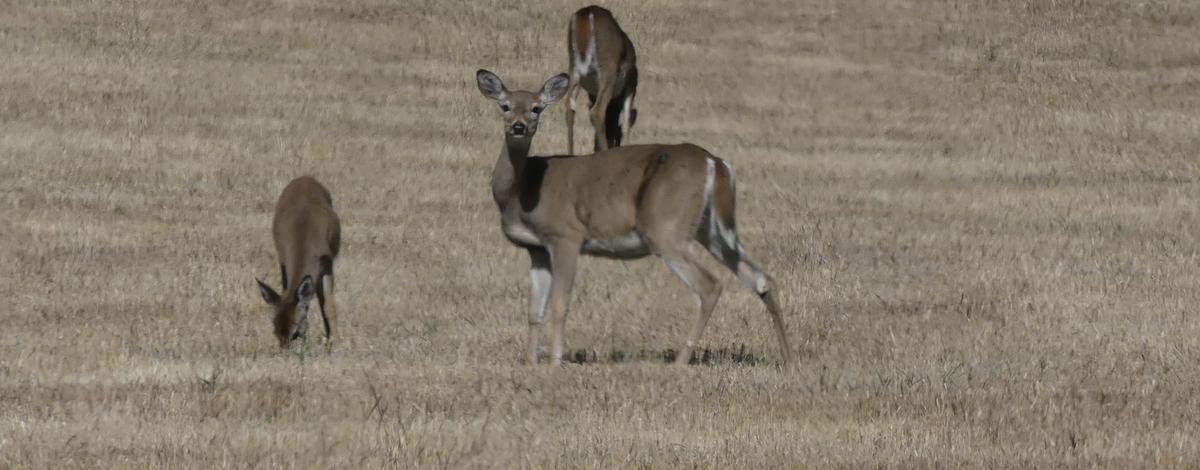Epizootic Hemorrhagic Disease (EHD) continues to cause an increase in the number of deer deaths across the Clearwater Region. Every year, Idaho Fish and Game receives reports of deer potentially infected with EHD in small, isolated outbreaks. Although EHD is a naturally occurring disease in Idaho, this summer's prolonged hot, dry summer with little rain caused animals to congregate intensifying the occurrence and duration of this year's EHD outbreak.
As usual water sources become scarce on the landscape, more deer use any water that is available. As deer gather around these water sources, more deer in the population may become exposed to infected biting midges, which spread the disease via bites from the insects. Higher deer concentrations can further exacerbate an outbreak as more deer frequent these watering holes.
History
In 2003, the Clearwater Region experienced a major outbreak of hemorrhagic disease starting in the Kamiah area. A less severe outbreak of bluetongue occurred during 2015 within the Clearwater Region.
Immunity
The disease is characterized by the rapid onset of clinical symptoms. Some deer can survive the late stages of the disease, and not all deer that become infected will become sick enough to show clinical signs. Deer that survive the original infection may become immune to EHD, and will carry antibodies in their blood. Due to the potential for immunity, Fish and Game encourages public to keep their distance and to not shoot or harass/stress visibly sick deer.
External Signs of EHD
Loss of appetite and wariness, swelling around the head and neck, dehydration and weakness, increased respiration rate, excessive salivation, rosy or bluish color of mouth and tongue, blood flecks may occur in the urine and feces. In severe cases, a bloody diarrhea can develop. Deer that are infected may show lameness and a tendency to avoid direct sunlight. An increase in body temperature can cause deer to seek cool places, such as in and around water.
Internal Signs of EHD
Internal organs will have extensive bleeding throughout, most likely affecting the heart, liver, spleen, kidney, lungs, and intestinal tract. The liver, spleen, and lymph nodes may be enlarged and congested. Lesions or ulcers may occur on the lips, tongue, and cheeks.
Treatment and Control
There is no treatment for EHD once the animal shows clinical signs. There are no preventive methods that are currently being applied to wild populations of deer. According to Infectious Diseases of Wild Mammals (2001), there is no established public health risk associated with handling or eating animals infected with EHD or with exposure to EHD-infected midges.
Idaho Fish and Game EHD Monitoring
Idaho Fish and Game primary method for monitoring EHD outbreaks is through reports of individuals who suspect a sick or dead deer has EHD. These reports are collected through the Wildlife Health Lab. Once an area is confirmed to have EHD, Idaho Fish and Game uses the online reporting to monitor the spread and extent of the disease. Idaho Fish and Game staff also maintain contact with counterparts in surrounding states to monitor the EHD status more broadly.
Idaho Fish and Game Disease Management
Because EHD is a naturally occurring disease in deer and there is no effective treatment for wild deer, Idaho Fish and Game only monitors for the disease and then assesses the potential effect of the disease on local deer populations as the season progresses. Deer can continue to be infected by EHD for about two weeks after the first significant frost and may be found dead for another couple of weeks.
What You Can Do
Idaho Fish and Game needs your help monitoring EHD in Idaho. Because EHD affects deer every year on a small, localized scale, it can be difficult to determine if reports are due to a major outbreak. Idaho Fish and Game asks that you report deer that appear to have died of EHD (e.g., found dead near water or exhibit signs listed above) via the online reporting system. This will allow Idaho Fish and Game to develop a baseline level of EHD in the state and help determine when a major outbreak is occurring.
At the expense of Idaho Fish and Game, dead deer can be taken to the following locations;
Simmons Sanitation, 3226 Highway 12 Kamiah, ID (208) 935-2617
Latah Sanitation, 3299 Hwy 8, Moscow, ID (208) 882-5724
Clearwater County Transfer Station, 585 Transfer Station Rd. Orofino, ID 83544 (208) 476-7903
Timberline Container Site, 3913 Hjalmar Johnson Rd., Weippe, ID 83553 (208) 435-4965
Fish and Game encourages neighbors to help neighbors. If you or you know of someone that has a dead deer on their property, please assist them with removal.
For more information, contact the Clearwater regional office at (208) 799-5010.

